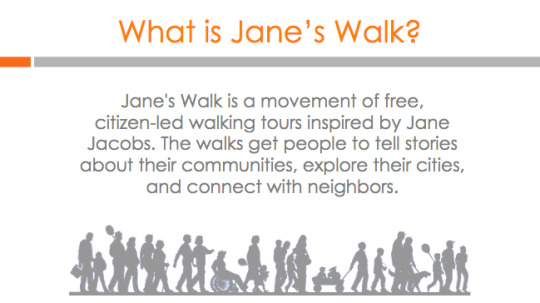Lead a Jane’s Walk this May in your neighborhood

Jane’s Walk is happening the first weekend of May (5th-6th-7th).
Last year, 1,000+ walks happened all over the globe!
Think of this as an opportunity to:
- start a conversation with your neighbors,
- continue highlighting safety issues that have been identified through initiatives like Boston’s Neighborhood Slow Streets application process
- get outside and enjoy a weekend in May!
Create your walk idea on Janeswalk.org, or get in touch with us at WalkBoston (contact Brendan!). We’re happy to help you or your neighbors with suggestions, promote your walk, and answer any questions you may have.
We look forward to helping you get out walking!
Edit: We’ll add neighborhoods/cities/towns below that will be hosting walks on this post (and include links to the separate walks within the communities as we find out about them.)
Boston – West End – “Jane’s Walk West End Tour”
Meet at the West End Museum
Saturday, May 6, 2pm
http://janeswalk.org/united-states/boston/janes-walk-west-end-tour/
Boston – West Roxbury – “West Roxbury Walk Audit”
Meet at the Hastings Street Lot
Saturday, May 6, 2pm
http://janeswalk.org/united-states/boston/west-roxbury-walk-audit/
Boston – Jamaica Plain – “Growing the City: Washington St from Forest Hills to Green St”
Meet at Brassica Kitchen & Cafe
Sunday, May 7, 11am
http://janeswalk.org/united-states/boston/growing-city-washington-st-forest-hills-green-st/
Boston – Roslindale – “Roslindale Gateway Path & proposed Blackwell Path Extension”
Meet at SE corner of the Arboretum (look for Walk UP Roslindale Banner)
Sunday, May 7, 1pm
http://www.walkuproslindale.org/weblog/2017/04/21/janes-walk-planned-sunday-may-7-at-1-pm-start-at-the-southeast-corner-of-the-arboretum/
Cambridge – “The Dense Layers of History in Old Cambridge”
Meet at Out of Town News Kiosk, Harvard Square
Saturday, May 6, 10:30am
http://www.janejacobswalk.org/upcoming-2017-walks/the-dense-layers-of-history-in-old-cambridge
Worcester – Jane Week (May 1 – 7, 2017) gives Worcester residents and visitors a chance to connect to each other, explore Worcester by foot and participate in interesting discussions on how we can enhance the design and function of our city. – 20+ events and walks throughout Worcester.
http://janeswalk.org/united-states/worcester-ma/
Lowell – “Labor Movement in Lowell”
Meet at Lowell National Park Visitor Center, 246 Market St
Saturday, May 6, 10:30am
http://richardhowe.com/event/labor-movement-in-lowell-walk/
Dedham – “Walking Tour of Proposed Dedham Heritage Rail Trail”
Meet at the parking lot by the football field/track on Whiting Ave
Sunday, May 7, 4:00pm
Saturday, May 13, 10:00am
http://mailchi.mp/f20ef35375c4/rail-trail-happenings-this-spring
Somerville – “A Metamorphosis of Industrial Buildings Along the Rails”
Kickoff to Somerville’s Preservation Month, ending at Aeronaut Brewery
Saturday, May 13, 9:30am
http://janeswalk.org/united-states/somerville-ma/meta/
Boston – Jamaica Plain – “Walking Tour of Monument Square”
July 1 & August 19, 12:45pm
http://janeswalk.org/united-states/boston/walking-tour-o/